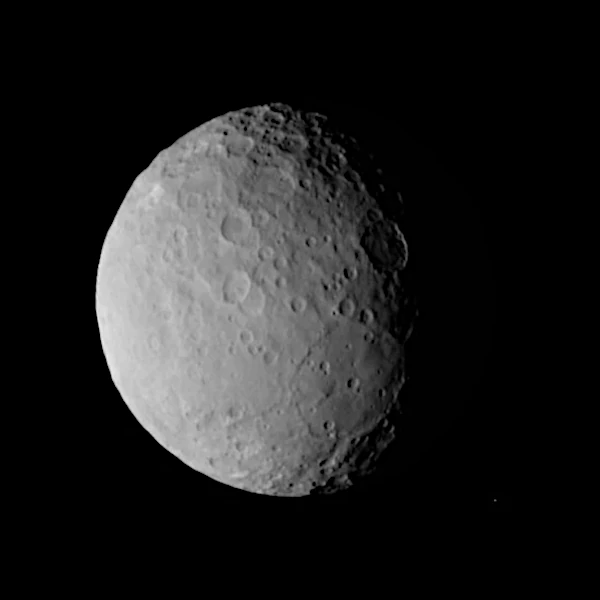
Ceres is the largest object in the main asteroid belt located between Mars and Jupiter. Officially classified as a dwarf planet since 2006 by the International Astronomical Union (IAU), it represents a physical and taxonomic boundary between asteroids and dwarf planets. This duality raises fundamental questions about its physical properties, formation, and evolution.
Ceres has an average diameter of about 940 km, making it the largest object in the asteroid belt. Its mass, estimated at 9.39 × 1020 kg, represents about 30% of the total mass of the main belt. Its average density, about 2.16 g/cm3, indicates a mixed composition of silicate rocks and water ice. This intermediate density is a key physical indicator, revealing that Ceres is not a simple rocky asteroid but contains a significant amount of volatile material.
N.B.:
The main volatile material contained in Ceres is water ice, accompanied by hydrated minerals and probably traces of other volatile compounds such as ammonia. This composition largely explains its intermediate physical properties between a rocky asteroid and an icy dwarf planet.
Gravitational studies and observations from the Dawn mission have shown that Ceres is likely differentiated: a dense rocky core would be surrounded by a mantle of water ice that is partially or completely solid. This process of physical differentiation assumes sufficient internal heat, possibly generated by radioactive decay and gravitational contraction, allowing the separation of materials according to their density.
The IAU defines a dwarf planet as a celestial body that orbits the Sun, has sufficient mass for its gravity to make it adopt a hydrostatic shape (almost spherical), but has not cleared its orbit of other debris. Ceres meets these criteria: its shape is almost spherical (hydrostatic equilibrium shape confirmed by precise measurements), but its orbital region is not very clear, unlike classical planets.
Asteroids, on the other hand, are generally smaller, often irregular, and not differentiated (no distinct internal layers), although the distinction is not absolute. Ceres is therefore at the crossroads of the two categories, which explains its hybrid status.
Due to its physical properties and location, Ceres constitutes a natural laboratory for understanding the processes of planetary formation, particularly the transition between small bodies and planets. The presence of ice water and past or present cryovolcanic activities also highlights the geophysical complexity of this body.
| Characteristic | Ceres | Typical Asteroid | Typical Dwarf Planet |
|---|---|---|---|
| Diameter (km) | ≈ 940 | 10 - 500 (e.g., Vesta ≈ 525 km) | Several hundreds to thousands (Pluto ≈ 2377 km) |
| Density (g/cm3) | 2.16 (indicating ice and rock) | 2.0 - 3.5 (mainly rocky or metallic) | 1.8 - 2.1 (e.g., Pluto 1.85; Eris 2.52) |
| Shape | Almost spherical (hydrostatic equilibrium shape) | Often irregular | Almost spherical |
| Internal differentiation | Presumed (rocky core + icy mantle) | Often undifferentiated | Yes, differentiated |
| Orbital clearance | No (main belt) | No | No (unlike classical planets) |
Source: NASA Solar System Exploration - Ceres, Russell et al. (2015), Science, IAU - Definition of Dwarf Planets 2006.